Container shipments through Port Elizabeth have all but been becalmed since October last year. According to Transnet National Ports Authority (TNPA) figures the volume of landed full and empty containers through Port Elizabeth over the past year has dropped from a high of 10 233 in September last year to 2 183 in May – the latest available figures. Exports have tanked from an October 2018 high of 13 157 to 1 435 in May. This follows the blowing of one of the two remaining functional ship to shore gantry cranes into the harbour. The remaining crane is being kept alive by cannibalising parts from two other gantries taken out of service in the harbour. Transnet has announced no plans to make Port Elizabeth more than a one-gantry port – taking it back more than 20 years in capacity. The traffic would seem to have been lost to the Eastern Cape because it has not moved significantly to Ngqura. The total number of landed containers has stayed relatively stable, peaking at 38 656 in November to 35 576 in May this year. There was only an increase of 97 containers between the September sinking of PE numbers and October. In November the number spiked to 38 656 ahead of the December buying season, and then dropped to 22 284 in December. Exports through Ngqura peaked at 69 684 in November, dropping to 31 812 in May this year. Problems in the port of Durban following last year’s storm in October will have contributed to the figures. Overall, the volumes of exports and imports are pretty well balanced – 388 117 containers were landed in the 12 months and 394 942 shipped (a difference of 6 825). However, with a design capacity of two million TEUs a year and volume of 783 059 in the past year, the port is performing well under its capacity – a fact that shipping lines using the port point out privately. East London remains a feeder port which, as anyone driving between Port Elizabeth and East London knows, has not been able to take trucks off the road. It averaged 2 276 landed containers a month in the 12 months June 2018 to May 2019. Most would be handled by geared vessels as the port has only one rubber tyred gantry. By far the majority were full – an average of 94 were empty. An average of 2 244 was shipped per month. Of these 1 394 on average were empty. The figures show an anomaly of -60 empty containers landed through East London in June 2018 and -284 in April. Port Elizabeth quays are now kept busy moving manganese bulk and vehicles. In January this year it handled 3 835 vehicles (import and export), 12 482 in February, 9 475 in March, 16 855 in April and 12 079 in May. Vehicle shipments are also keeping the lights on in East London – 3 754 in January, 5 154 in February, 9 098 in March, 10 166 in April and 6 528 in May. In comparison, Durban handled 36 691 vehicles in January, 41 041 in February, 36 704 in March, 36 161 in April, and 41 264 in May. Brexit and Donald Trump both threaten the export volumes through the Eastern Cape. Port Elizabeth has transformed into a bulk port, despite Transnet promising to move the manganese container operations for more than a decade. Dry bulk cargo volumes average 765 000 tons a month .

